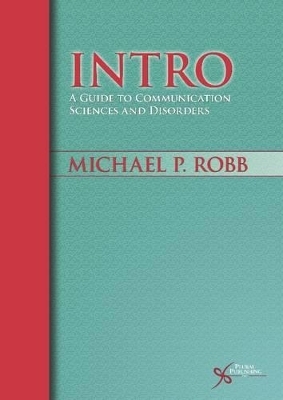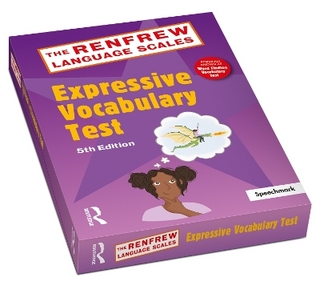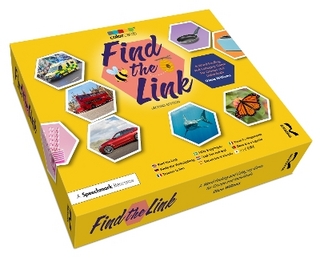
INTRO: A Guide to Communication Sciences and Disorders
Plural Publishing Inc
978-1-59756-339-0 (ISBN)
- Titel ist leider vergriffen;
keine Neuauflage - Artikel merken
Several books on the general topic of introduction to communication disorders have been published between 2000 and 2009. Why then publish another one on this topic? The answer is that this new text satisfies the need for an introduction that is written with a welcoming and uniform style across chapters and that presents richly illustrated discussions that weave historical notes and contemporary discoveries into a cohesive account of the broad spectrum of communication disorders. Designed for beginning university-level students, this book provides essential information presented in a straightforward and engaging manner on a wide range of communication disorders found in children and adults. The author's experience in teaching an introductory class is evident in the book's student-friendly approach and its effective presentation of the core information in the field. The book is organized into four sections. Section 1 provides background information related to communication disorders. The chapters in this section cover the topics of communication science, the professions of audiology and speech-language pathology, and anatomy and physiology.
Section 2 is concerned with developmental communication disorders, and includes chapters on child language disorders, child phonological disorders, and fluency disorders. Section 3 covers acquired communication disorders. The chapters in this section describe voice disorders, cleft lip and palate, neurogenic communication disorders, dysphagia, and genetic-based communication disorders. Section 4 addresses audition and contains chapters on hearing disorders and aural rehabilitation. Unique aspects of the book include the use of a recurring structure across chapters to assist beginning students to grasp new vocabulary and concepts while understanding the relationships among the different disorders. Each chapter also provides a focus on "past and present." Each disorder is introduced with a fascinating look at formative history, as well as up-to-date information concerning current theories and research. The book holds worldwide appeal and is written for an international audience.
A portion of each chapter is dedicated to cultural aspects of communication disorders, as well as epidemiological information on communication disorders as found in English-speaking countries around the world, including Australia, Canada, the United Kingdom, the United States, and New Zealand. Websites listed at the end of the chapters guide students to opportunities to learn more about each topic. Many of these websites provide links to streaming video examples. The sole authorship of the book ensures a balanced and uniform writing style that is missing from many introductory texts. INTRO is a clear and concise primer that delivers fundamental information about the variety of communication disorders that occur across the lifespan. For some, this information will serve as a springboard for pursuit of a professional career in audiology and speech-language pathology. But all readers will acquire an appreciation of the gift of communication that is so often taken for granted. Free to instructors, more than 200 PowerPoint slides conveniently divided into chapters for ease of use and chapter quizzes with answers.
Michael Robb, PhD Michael P. Robb has worked as a speech-language pathologist at the Meyer Children's Rehabilitation Institute in Omaha, Nebraska (now known as the Munroe-Meyer Institute for Genetics and Rehabilitation). Since obtaining his PhD, he has held faculty posts at the University of Hawaii, the University of Connecticut, and most recently at the University of Canterbury in Christchurch, New Zealand.
Preface Section 1- BACKGROUND TO COMMUNICATION DISORDERS Chapter 1: Communication Science Objectives Terminology and Definitions Animal Communication History of Human Communication Models of Communication Forms of Communication Levels of Communication Current Research in Communication Science Communication Science on the World Wide Web References Chapter 2: Communication disordes and the Professions Objectives Terminology and Definitions The Professions History of the Professions Educational Preparation Professional Work Settings Professional Code of Ethics Cultural Considerations and Communication Disorders Current Issues in the Professions The Professions of Audiology and Speech-Language Pathology on the World Wide Web References Chapter 3: Anatomical Processes of Speech and Hearing Objectives Speech Anatomy The Process of Speech Production Hearing Anatomy The Process of Hearing Historic Aspects of Anatomy and Physiology Cultural Considerations and Anatomy and Physiology Current Research in Speech and Hearing Anatomy and Physiology Anatomy and Physiology on the World Wide Web References Section 2 - DEVELOPMENTAL COMMUNICATION DISORDERS Chapter 4: Child Language Disorders Objectives Terminology and Definitions Language Development Historic Aspects of Child Language Disorders Types of Child Language Disorders Current Theories Regarding Child Language Disorders Assessment of Child Language Disorders Treatment of Child Language Disorders Cultural Considerations and Child Language Disorders Current Research in Child Language Disorders Child Language Disorders on the World Wide Web References Chapter 5: Child Phonological Disorders Objectives Terminology and Definitions Historic Aspects of Child Phonological Disorders Types of Phonological Disorders Current Theories Regarding Child Phonological Disorders Assessment of Child Phonological Disorders Treatment of Child Phonological Disorders Cultural Considerations and Child Phonological Disorders Current Research in Child Phonological Disorders Child Phonological Disorders on the World Wide Web References Chapter 6: Fluency Disorders Objectives Terminology and Definitions Historic Aspects of Fluency Disorders Types of Fluency Disorders Current Theories Regarding Stuttering Assessment of Fluency Disorders Treatment of Fluency Disorders Cultural Considerations and Fluency Disorders Current Research in Fluency Disorders Fluency Disorders on the World Wide Web References Section 3 - ACQUIRED COMMUNICATION DISORDERS Chapter 7: Voice Disorders Objectives Terminology and Definitions Historic Aspects of Voice Disorders Types of Voice Disorders Current Theories of Voice Disorders Assessment of Voice Disorders Treatment of Voice Disorders Cultural Considerations & Voice Disorders Current Research in Voice Disorders Voice Disorders on the World Wide Web References Chapter 8: Cleft Lip and Palate Objectives Terminology and Definitions Historic Aspects of Cleft Lip and Palate Disorders of Cleft Lip and Palate Current Theories of Cleft Lip and Palate Assessment of Cleft Lip and Palate Treatment of Cleft Lip and Palate Cultural Considerations and Cleft Lip and Palate Current Research in Cleft Lip and Palate Cleft Lip and Palate on the World Wide Web References Chapter 9: Neurogenic Communication Disorders Objectives Terminology and Definitions Historic Aspects of Neurogenic Disorders Types of Neurogenic Communication Disorders Current Theories Regarding Neurogenic Communication Disorders Assessment of Neurogenic Communication Disorders Treatment of Neurogenic Communication Disorders Cultural Considerations and Neurogenic Communication Disorders Current Research in Neurogenic Communication Disorders Neurogenic Disorders on the World Wide Web Video Examples Chapter 10: Dysphagia Objectives Terminology and Definitions Historic Aspects of Dysphagia Types of Dysphagia Causes of Dysphagia Assessment of Dysphagia Treatment of Dysphagia Cultural Considerations and Dysphagia Current Research in Dysphagia Dysphagia on the World Wide Web References Chapter 11: Genetics and Syndromes Objectives Terminology and Definitions Historic aspects of Genetics Types of Syndromes Assessment of Genetics and Syndromes Treatment of Genetic Conditions Cultural Considerations Regarding Genetics Current Research in Genetics Genetics and Syndromes on the World Wide Web References Section 4 - AUDITION Chapter 12: Hearing disorders Objectives Terminology and Definitions Historic Aspects of Hearing Disorders Types of Hearing Disorders Assessment of Hearing Disorders Cultural Considerations and Hearing Disorders Current Research in Hearing Disorders Hearing Disorders on the World Wide Web References Chapter 13: Auditory Rehabilitation Objectives Terminology and Definitions Historic Aspects of Aural Rehabilitation Treatment Approaches: Hearing Rehabilitation Treatment Approaches: Speech and Language Rehabilitation Cultural Considerations and Aural Rehabilitation Current Research in Aural Rehabilitation Aural Rehabilitation on the World Wide Web References Glossary of Terms Index
| Erscheint lt. Verlag | 1.2.2010 |
|---|---|
| Zusatzinfo | 4 colour illustrations |
| Verlagsort | San Diego |
| Sprache | englisch |
| Maße | 178 x 254 mm |
| Themenwelt | Medizin / Pharmazie ► Gesundheitsfachberufe ► Logopädie |
| Medizin / Pharmazie ► Gesundheitswesen | |
| ISBN-10 | 1-59756-339-0 / 1597563390 |
| ISBN-13 | 978-1-59756-339-0 / 9781597563390 |
| Zustand | Neuware |
| Haben Sie eine Frage zum Produkt? |
aus dem Bereich


